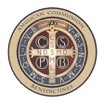Christ Mission Anglican Benedictines
Order of Saint Benedict

Dan Nobles – Abbot
June 2019
Customary
Introduction:
The following provides common information for use by the Order of Christ Mission Anglican Benedictines. As a disbursed order we are part of the New Monasticism envisioned and written about by Dietrich Bonhoeffer. Our members serve Christ and one another in their communities and under our understanding of the Rule of Saint Benedict. We are guided by and part of the Benedictine tradition.
Monastic Habit Supplier:
The robe and scapular that are part of the order’s habit may be purchased through the supplier noted below. The robe and scapular are both black.
https://gloryandpraisevestments.com
Wearing of the Monastic Habit:
Stages of Formation
- Aspirant: N/A
- Postulant: N/A
- Novice: robed, white cincture (and white veil for sisters) and Benedictine medallion.
- Juniorate: robed, black cincture, Benedictine cross, and black scapular (hooded for brothers or collarette and black veil for sisters).
- Solemn Vows: robed, black leather belt, Benedictine cross, and scapular (hooded for brothers or collarette and black veil for sisters).
The Benedictine Cross: Should be worn by professed members whenever possible and practical as a sign of commitment and belonging to the Order. This means worn with clericals and choir dress for clergy, when in monastic clothing, and with civilian clothing (visible or under clothing). See Abbot for your cross or medallion.
Forms of Address and Use of Initials:
All members of the Order of Saint Benedict are brothers and sisters in Christ. No member is less than another member simply because of the office they hold or their function within the order. Members have different functions so that they may best serve the order based on their skills, talents, experience and the needs of the order. Members are called at all times to respect one another.
Styles of Offices
- Abbot
- Verbal: Father Abbot or Abbot first name
- Written: The Venerable Abbot first name, last name
- Salutation: Dear Father Abbot or Dear Abbot.
- Prior
- Verbal: Prior/Prioress first name (if a priest)
- Written: Prior/Prioress first name, last name (if a priest)
- Salutation: Dear Prior/Prioress first name
- Sub-Prior (Sub-Prioress): Follow same rules as with the Prior/Prioress
- Porter
- Verbal: Porter first name
- Written: Porter
- Salutation: Dear Father, Sister or Brother
*Note: Members of the order who have held monastic office and been granted emeritus status follow the above protocols.
- Member of order (non-monastic office holder)
- Verbal: Father or Reverend first name (if a priest)
- Verbal: Brother or Sister Deacon (if a deacon) or Simply Brother or Sister first name (novice through solemn profession)
- Verbal: Brother or Sister first name (anyone novice through solemn profession)
- Written: Same as Above
- Salutation: Dear Fr./Rev./Dcn./Sr./Br.
*Note: Lay brothers and sisters in the order should be judicious in using the title of “Br.” or “Sr.”. It should be used in appropriate settings such as within the order, when interacting with other orders and in certain church situations. It should not be used in secular settings unless approval of the Abbot has been secured.
Use of Initials
The following initials may be used after a member’s name. At no time should the initials or Benedictine identity be used with a political cause, commercial enterprise or any other endeavor, which could bring the order into disrepute.
- Aspirant: N/A
- Postulant: N/A
- Novice: n/OSB
- Juniorate: OSB
- Solemn Vows: OSB
Religious Names
From ancient times, vowed Religious persons have taken Religious Names to signify the new life they are called to through their vows. The precedent stems from biblical examples such as Abram and Sarai were God gave them new names; Abraham and Sarah. Jesus told Simon that he would be called Peter. Our community honors this practice.
- When one professes their permanent solemn vows, should they choose, they may take a Religious Name to be used in our community. Within the community, they are free to use their Religious Name in all contexts.
- Religious Names should be taken only after great discernment and with the permission and approval of the Abbot.
- Religious Names have the potential of being confusing. Therefore, persons taking a Religious Name should use that name only within the community. There is no legal status presumed by taking this name unless further actions are taken by the individual to legally change their given name. Such action must be approved by the Abbot prior to pursuing legal name change.
- A Religious Name will be considered an alias and must be reported as such on certain legal documents when requested.
Deceased Members of the Order:
A member of the order may choose to be buried in their habit (as is monastic tradition). Members of their family should notify the Abbot as soon as possible of the serious illness or death of a member of the order. Deceased members will be remembered in the order’s necrology.
